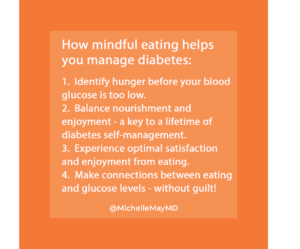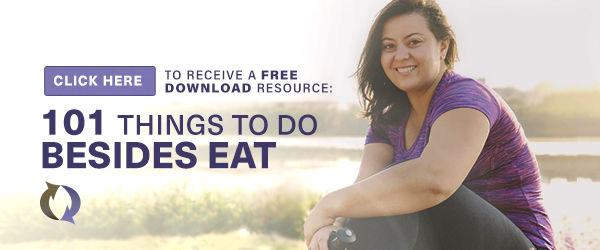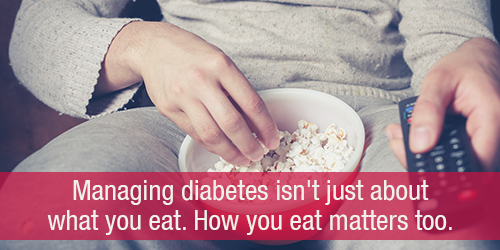By Michelle May, M.D., co-author of Eat What You Love, Love What You Eat with Diabetes
Managing diabetes isn’t just about what you eat. How you eat matters too. Read on to discover simple steps for getting out of autopilot. Mindful eating and diabetes self-management work beautifully together!
Do you eat on autopilot?
 Have you ever finished a meal and wished you had just one more bite? Are you surprised when your hand hits the bottom of the popcorn bucket at the movies? Do you ever feel completely stuffed and miserable after you eat?
Have you ever finished a meal and wished you had just one more bite? Are you surprised when your hand hits the bottom of the popcorn bucket at the movies? Do you ever feel completely stuffed and miserable after you eat?
These are symptoms of mindless or unconscious eating.
Many people eat while they watch TV, drive, work—even while talking on the phone. And many people eat too fast, so busy filling the next forkful that they don’t notice the bite in their mouth. Since your brain can only really focus on one thing at a time, you may miss the subtle signs of fullness. As a result, you may not stop eating until you feel uncomfortable or you run out of food.
Most important, when you eat mindlessly, you won’t enjoy your food as much, so you may eat more to feel satisfied. And that can play havoc with your blood sugar!
How mindful eating helps diabetes
Eating is a natural, healthy, and pleasurable activity that meets your fuel and nutritional needs. And, there are many ways that eating mindfully can help with diabetes management.
 When you have diabetes, mindfulness will help you identify hunger before your blood glucose it too low.
When you have diabetes, mindfulness will help you identify hunger before your blood glucose it too low.- Consciously choosing foods that are great balance of nourishment and enjoyment is one key to a lifetime of diabetes self-management.
- Choosing to eat mindfully, in other words, giving food and eating your full attention, will allow you to experience optimal satisfaction and enjoyment.
- Mindful eating also makes it possible for you to explore the difference between physical satisfaction and feeling overly full.
- Mindful eating may lead you to feel more satisfied with smaller quantities of food, which helps with blood glucose management.
- Learning to savor your food simply makes eating more pleasurable!
- Mindful eating helps you make connections between eating and glucose levels – without judgment or guilt!
How to eat mindfully with diabetes
Try the following strategies to help you identify your body’s signals and truly enjoy your food:
Start by recognizing whether you’re hungry before you begin eating. If you aren’t hungry, you won’t be as interested, so it will be harder to stay focused. Besides, sometimes “I want a brownie” really means “I want a break.” If a craving doesn’t come from hunger, eating won’t usually satisfy it.
Don’t wait until you’re famished.One of the keys to conscious eating is to keep your body adequately fed to avoid becoming overly hungry, which increases the likelihood you’ll overeat. Check your blood glucose to help you learn how to identify hunger before you are too low.
Next, decide how full you want to be when you’re finished eating. When you eat with the intention of feeling better when you’re done eating, you’re less likely to keep eating until the food is gone.
Choose food that will satisfy both your body and your mind. Our society is so obsessed with eating “right,” we sometimes eat things we don’t even like. However, satisfaction comes not just from physical fullness but from enjoying the taste of your food without guilt. Deprivation and guilt causes more overeating, not less.
Set the table in a pleasant manner. Creating a pleasant ambience adds to the enjoyment of eating and to your level of satisfaction. Besides, you deserve it.
Minimize distractions. If you eat while you’re distracted by watching television, driving, or talking on the phone, you won’t be giving your food or your body’s signals your full attention. As a result, you may feel full but not satisfied.
Eat when you’re sitting down. Choose one or two particular areas at home and at work that are only used for eating and try to eat there. For example, you’ll find it helpful to avoid eating while standing over the sink, peering into the refrigerator, or sitting in bed.
Take a few breaths and center yourself before you begin eating. This will help you slow down and give eating your full attention.
Express gratitude for your food. Appreciate the atmosphere, the company, or simply the fact that you’re giving yourself the opportunity to sit down and enjoy your meal.
Appreciate the aroma and the appearance of your food. Notice the colors, textures, and smells of the food and imagine what it will taste like.
Decide which food looks the most appetizing and start eating that food first. If you save the best until last, you may want to eat it even if you’re already full.
Savor the aromas and tastes of your food as you eat it. Stay conscious of all the different sensations you’re experiencing.
Put your fork down between bites. If you’re busy loading your next forkful of food, which bite are you paying attention to? The next one!
If you notice that you’re not enjoying what you chose, choose something else if possible. Eating food you don’t enjoy will leave you feeling dissatisfied.
Pause in the middle of eating for a couple of minutes. Notice whether you’re enjoying your meal and estimate how much more food it will take to fill you to comfortable satiety.
Push your plate forward or get up from the table as soon as you feel satisfied. The desire to keep eating will pass quickly. Keep in mind that you’ll eat again when you’re hungry.
Notice how you feel when you’re finished eating. And, if you check your blood sugars, notice the connections between what and how much you ate. What went well? What will you do differently next time? If you overate, don’t punish yourself. Instead, be aware of the physical and/or emotional discomfort that often accompanies being overly full and create a plan to decrease the likelihood that you’ll overeat next time.
Once you’ve experienced the increased pleasure from eating mindfully, you may be motivated to become more mindful during other activities too. Living “in the moment” and becoming more aware can increase your enjoyment and effectiveness in everything you do.
Want to learn more about Mindful Eating with Diabetes? Check out our self-paced course: Mindful Eating for Diabetes Online Class
This article was updated from a previous version.
Enjoyed this article? Here are three more to help you:
What is mindful eating and how can it help my diabetes?
Can you eat snacks and desserts with diabetes?



2 thoughts on “Mindful Eating and Diabetes: Get Out of Autopilot”
Great advice regardless of whether one is diabetic or not!
Comments are closed.